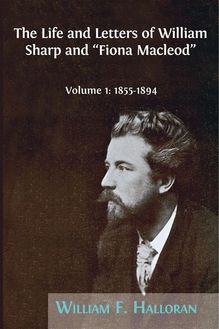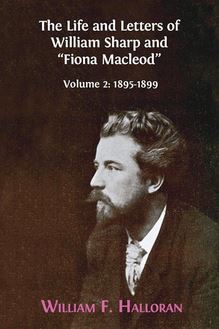The Life and Letters of William Sharp and "Fiona Macleod". Volume 1: 1855–1894 , livre ebook
374
pages
English
Ebooks
2018
Vous pourrez modifier la taille du texte de cet ouvrage
Obtenez un accès à la bibliothèque pour le consulter en ligne En savoir plus
Découvre YouScribe en t'inscrivant gratuitement
Découvre YouScribe en t'inscrivant gratuitement
374
pages
English
Ebooks
2018
Vous pourrez modifier la taille du texte de cet ouvrage
Obtenez un accès à la bibliothèque pour le consulter en ligne En savoir plus
Publié par
Date de parution
28 novembre 2018
Nombre de lectures
1
EAN13
9781783745036
Langue
English
Poids de l'ouvrage
5 Mo
Sharp wrote "I feel another self within me now more than ever; it is as if I were possessed by a spirit who must speak out". This three-volume collection brings together Sharp’s own correspondence – a fascinating trove in its own right, by a Victorian man of letters who was on intimate terms with writers including Dante Gabriel Rossetti, Walter Pater, and George Meredith – and the Fiona Macleod letters, which bring to life Sharp’s intriguing "second self".
With an introduction and detailed notes by William F. Halloran, this richly rewarding collection offers a wonderful insight into the literary landscape of the time, while also investigating a strange and underappreciated phenomenon of late-nineteenth-century English literature. It is essential for scholars of the period, and it is an illuminating read for anyone interested in authorship and identity.
Publié par
Date de parution
28 novembre 2018
Nombre de lectures
1
EAN13
9781783745036
Langue
English
Poids de l'ouvrage
5 Mo
THE LIFE AND LETTERS OF WILLIAM SHARP AND “FIONA MACLEOD” VOL. I
The Life and Letters of William Sharp and “Fiona Macleod”
VOLUME I: 1855–1894
William F. Halloran
https://www.openbookpublishers.com
©2018 William F. Halloran
This work is licensed under a Creative Commons Attribution 4.0 International license (CC BY 4.0). This license allows you to share, copy, distribute and transmit the text; to adapt the text and to make commercial use of the text providing attribution is made to the authors (but not in any way that suggests that they endorse you or your use of the work).
Attribution should include the following information: William F. Halloran, The Life and Letters of William Sharp and “Fiona Macleod”. Volume 1: 1855 – 1894 . Cambridge, UK: Open Book Publishers, 2018. https://doi.org/10.11647/OBP.0142
In order to access detailed and updated information on the license, please visit https://www.openbookpublishers.com/product/793#copyright
Further details about CC BY licenses are available at https://creativecommons.org/licenses/by/4.0/
All external links were active upon publication unless otherwise stated and have been archived via the Internet Archive Wayback Machine at https://archive.org/web
Updated digital material and resources associated with this volume are available at https://www.openbookpublishers.com/product/793#resources
Every effort has been made to identify and contact copyright holders and any omission or error will be corrected if notification is made to the publisher.
ISBN Paperback: 978-1-78374-500-5
ISBN Hardback: 978-1-78374-501-2
ISBN Digital (PDF): 978-1-78374-502-9
ISBN Digital ebook (epub): 978-1-78374-503-6
ISBN Digital ebook (mobi): 978-1-78374-504-3
ISBN XML: 978-1-78374-660-6
DOI: 10.11647/OBP.0142
Cover image: “Mr William Sharp: from a photograph by Frederick Hollyer: The Chap-book , September 15, 1894”, Wikimedia, https://upload.wikimedia.org/wikipedia/commons/6/6b/William_Sharp_1894.jpg . Cover design: Anna Gatti.
All paper used by Open Book Publishers is SFI (Sustainable Forestry Initiative), PEFC (Programme for the Endorsement of Forest Certification Schemes) and Forest Stewardship Council ® (FSC ® certified).
Printed in the United Kingdom, United States, and Australia by Lightning Source for Open Book Publishers (Cambridge, UK)
To the memory of
Noel and Rosemarie Sharp
and
Esther Mona Harvey
Contents
Acknowledgements
ix
Introduction
1
Chapter One: 1855–1881
9
Chapter Two: 1882–1884
65
Chapter Three: 1885–1886
133
Chapter Four: 1887–1888
175
Chapter Five: 1889
221
Chapter Six: 1890
267
Chapter Seven: 1891
317
Chapter Eight: 1892a
359
Chapter Nine: 1892b
409
Chapter Ten: 1893
459
Chapter Eleven: 1894
517
Notes
593
Appendix
683
List of Illustrations
695
Acknowledgements
William Sharp’s wife and first cousin, Elizabeth Amelia Sharp, became his literary executor when he died in 1905. Upon her death in 1932, the executorship passed to her brother, Noel Farquharson Sharp. When he passed away in 1945, that role fell to his son, Noel Farquharson Sharp, who like his father was a keeper of printed books in the British Museum. When he died in 1978, the executorship fell to his wife, Rosemarie Sharp, who lived until 2011 when it passed to her son, Robin Sharp.
I am heavily indebted to Noel and Rosemarie Sharp for their assistance and friendship. They granted me permission to publish William Sharp’s writings and shared their memories of his relatives and friends. I am especially grateful to Noel Sharp for introducing me in 1963 to Edith Wingate Rinder’s daughter, Esther Mona Harvey, a remarkably talented woman whose friendship lasted until her death in 1993. Her recollections of her mother, who played a crucial role in the lives of William and Elizabeth Sharp, were invaluable.
Through many years of my involvement with an obscure and complex man named William Sharp, my wife — Mary Helen Griffin Halloran —has been endlessly patient, encouraging and supportive. This work has benefited greatly from her editorial skills.
I am also grateful to a succession of English graduate students at the University of Wisconsin–Milwaukee who assisted me in transcribing and annotating William Sharp’s letters: Edward Bednar, Ann Anderson Allen, Richard Nanian, and Trevor Russell. Without the support I received from the College of Letters and Science and the Graduate School of the University of Wisconsin–Milwaukee this project would not have seen the light of day.
The following institutions have made copies of their Sharp/Macleod letters available and granted permission to transcribe, edit, and include them in this volume:
The American Antiquarian Society; Baylor University’s Browning Library; The British Library; The Brown University Library; The Library of Colby College; Columbia University’s Rare Book and Manuscript Library; The Edinburgh City Libraries; Harvard University’s Houghton Library; The Huntington Library of San Marino California; Indiana University’s Lilly Library; The Library of Congress; The Manx Museum on The Isle of Mann; The National Library of Scotland; The Newberry Library; The New York Public Library’s Berg Collection; New York University’s Fales Library; The Northwestern University Library; Oxford University’s Bodleian Library; Pennsylvania State University’s Pattee Library; The Pierpont Morgan Library in New York City; Princeton University’s Firestone Library; The Sheffield City Archives; The Smith College Library; The Stanford University Library; The State University of New York at Buffalo Library; The Library in Trinity College Dublin; The University of British Columbia Library; The University of California Berkeley’s University Research Library; The University of California Los Angeles’s William Andrews Clark Library; The University of Delaware Library; The University of Illinois Urbana Library; The University of Leeds’s Brotherton Library; The University of Texas Austin’s Library and its Henry Ransom Humanities Research Center; The University of Toronto’s Thomas Fisher Rare Book Library; The University of Wisconsin-Milwaukee’s Golda Meir Library; Yale University’s Beinecke Library.
The Appendix lists the letters owned by each institution in order to recognize their generosity and ease the way for scholars who may wish to consult the original manuscripts. Without these great libraries, their benefactors, and their competent and caring staffs, a project of this sort — which has stretched over half a century — would have been impossible.
Finally, this project would not have come to fruition had it not been for Warwick Gould, Emeritus Professor and former Director of the Institute for English Studies at the University of London. It was he who supported the first iteration of the Sharp letters as a website supported by the Institute, and it was he who suggested Open Book Publishers as a possible location for an expanded edition of The Life and Letters of William Sharp and Fiona Macleod . His support and friendship have been a beacon of light.
Introduction
© 2018 William F. Halloran, CC BY 4.0 https://doi.org/10.11647/OBP.0142.12
William Sharp was born in Paisley, near Glasgow, in 1855. His father, a successful merchant, moved his family to Glasgow in 1867; his mother, Katherine Brooks, was the daughter of the Swedish Vice Consul in Glasgow. A talented, adventurous boy who read voraciously, he spent summers with his family in the Inner Hebrides where he developed a strong attachment to the land and the people. In the summer of 1863, his paternal aunt brought her children from London to vacation with their cousins. Months short of his eighth birthday, Sharp formed a bond with one of those cousins, Elizabeth Sharp, a bright girl who shared many of his enthusiasms. Their meeting led eventually to their engagement (in 1875) and their marriage (in 1884).
After finishing school at the Glasgow Academy in 1871, Sharp studied literature for two years at Glasgow University, an experience that fed his desire to become a writer. Following his father’s sudden death in August 1876, he fell ill and sailed to Australia to recover his health and look for suitable work. Finding none, he enjoyed a warm and adventurous summer and returned in June 1877 to London where he spent several weeks with Elizabeth and her friends. A year later he settled in London and began to establish himself as a poet, journalist, and editor. Through Elizabeth’s contacts and those he made among writers, including Dante Gabriel Rossetti, he became by the end of the 1880s a well-established figure in the literary and intellectual life of the city. During this decade he published biographical studies of Rossetti, Percy Bysshe Shelley, and Robert Browning; three books of poetry; two novels; many articles and reviews; and several editions of other writers. None of those publications brought the recognition he sought. By 1890 he had accumulated enough money to reduce his editing and reviewing and devote more time to poetry and prose.
That autumn he and Elizabeth went to Heidelberg for several weeks and then to Italy for the winter. In January, Edith Wingate Rinder, a beautiful young woman and the wife of Frank Rinder, accompanied her aunt, Mona Caird, a close girlhood friend of Elizabeth, on a three-week visit

